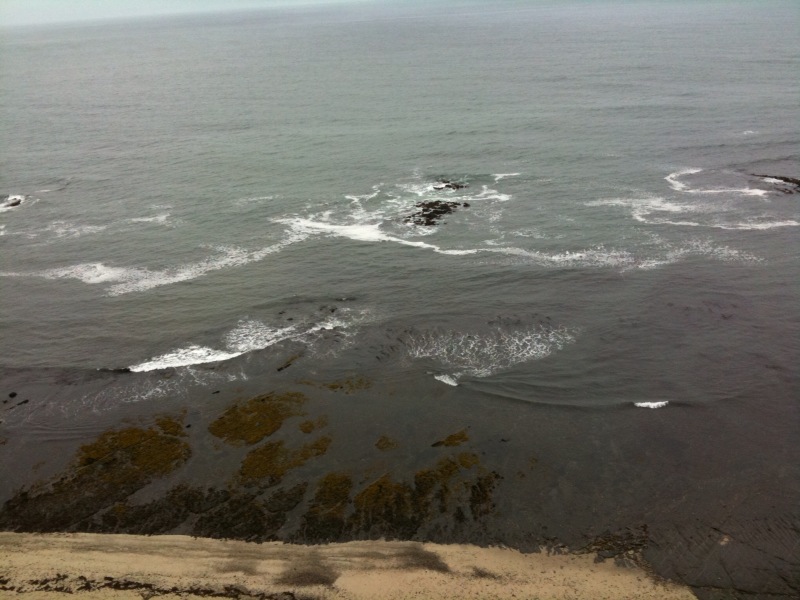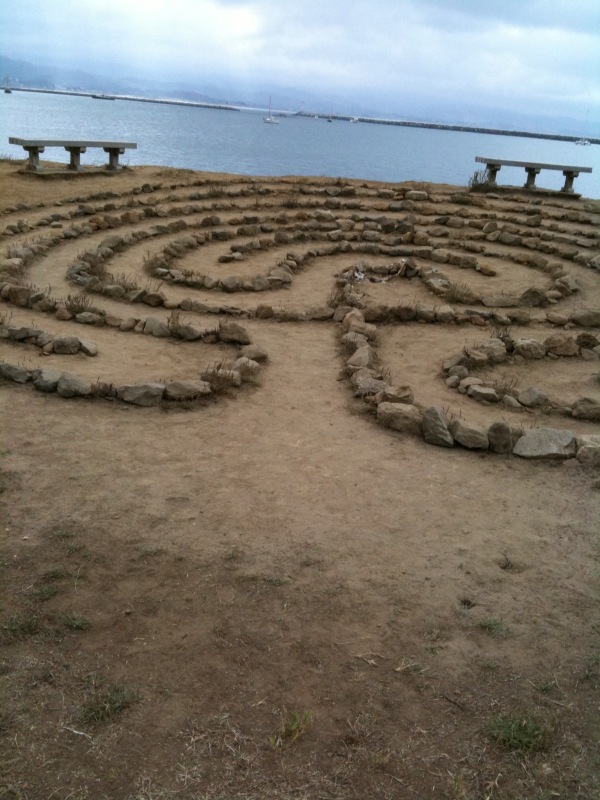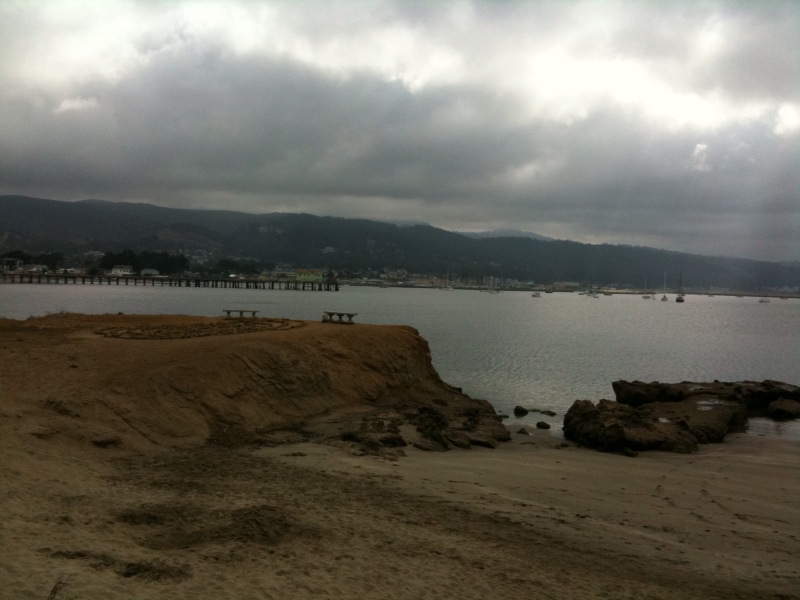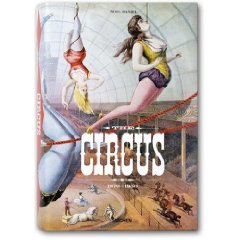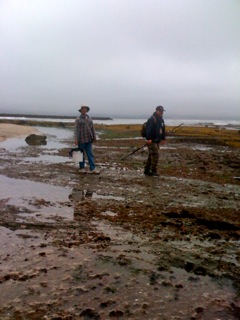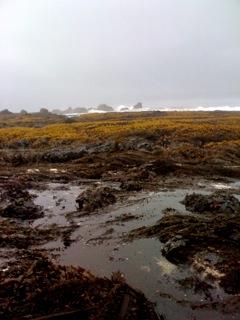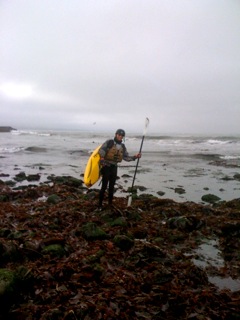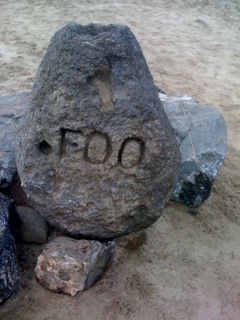A new-old story by June Morrall
“How the waters were calmed at Princeton-by-the-Sea
“In the 1950s while the demolition ball continued to obliterate the Peninsula’s historic landmarks, the Coastside remained frozen in time. Visitors found the agricultural town of Half Moon Bay comfortably unchanging. Rural Main Street remained familar and the artichoke fields and ocean vistas constant.
“But even in peaceful Half Moon Bay, population 2,000, a seed of change was germinating. Prominent citizens lobbied hard for a breakwater at Pillar Point, its purpose to create a true, safe harbor.
“Leading the charge was 74-year-old George Dunn, Sr. This was not the first time Dunn had been deeply involved in Coastside politics. He was a lone surviving member of an original group of influential locals who met in 1911 to discuss how to protect fishing boats from being battered by the heavy seas accompanying harsh seasonal storms.
“Dunn always remembered that grim meeting at Patroni’s Italian restaurant at Princeton-by-the-Sea. Half Moon Bay was mourning the loss of some of its fishermen to a savage winter storm. The fierce winds and deadly waves had spilled the fishing boats, claiming its victims.
“Present among the stone-faced men were big El Granada landowners, John Patroni and Danite Dianda, as well as Harr Wagner, the pubisher/editor hwo founded the Montara Arts Colony.
“All agreed that the boats had been trapped because Half Moon Bay, naked to the sea, provided no safe refuge. Able to navigate but a few miles an hour, the fishing boats could not reach the protection afforded by the harbors at San Francisco or Monterey. The winter storms would always be there and unless these leading citizens could provide a solution the community would face tragedy again.
“Only a breakwater could have saved those lives, the group concluded, a wall of stone behind which the boats could run.
“Despite the passion displayed by the small band that met at Patroni’s restaurant in 1911, their plans fell on deaf ears, and nothing happened. But George Dunn, Sr. refused to allow the project to die, and 42 winters later he was as bold as ever in pushing his program.
“‘Half Moon Bay is an important agricultural center,” said Dunn, “but we won’t stop there. We are fighting for a $5,500,000 Half Moon Bay breakwater. San Mateo County had pledged $450,000 for the project.’ But the breakwater was no closer to reality in 1953 than it had been in 1911.
“Although it was a small postcard picture perfect town, Half Moon Bay provided artichokes and Brussels sprouts for the entire nation. The Half Moon Bay Grower’s Association was its most powerful agency, crating, freezing and shipping these vegetables to all points.
“Vegetables were not the only crop. Heather thrived in the ideal flower growing climate, helping to account for the Coastside’s share of the $16 million a year floriculture industry.
“All the while the hearty fishermen harvested their bounty from the sea as they had been doing for generations. This was the unchanging, magnificent Coastside.
“The rest of the county was bursting with new homes and businesses, transforming the landscape into sprawling suburbs. To some, these fast changes were unsettling. A visit to the Coastside in the 1950s acted as a stress-reducing palliative as one could rely on things remaining as they always had been.
“Perhaps it was nostalgia that lured the visitors to return again and again. The weekend excursions on the Coast Highway were soaked with memories of friendly roadhouses in Miramar, Moss Beach and Princeton. Two decades earlier these visitors or their parents might have gone to the same places for delicious or an illegal glass of bootleg whiskey.
“In the 1950s when you stopped at tiny Princeton-by-the-Sea near Pillar Point [and the future Mavericks], kind-hearted Hazel Teixeira was always present. like a fixture, taking orders at her wharfside restaurant with the blue tinted windows. It didn’t take much imagination to hear the ghostly sounds of the Ocean Shore Railroad as the cars chug-chugged along the tracks.
“Forty years earlier, in 1910, it was the safety of the fishing boats that cried out for the need of a breakwater. Now, George Dunn, Sr., expanded his case. In addition to the economic benefits, he fervently believed construction of a breakwater was essential to put the brakes on the erosion that he witnessed all around him.
“To the never-changing image of the Coastside, this was the germinating seed of change that Dunn nurtured.
“Pointing toward Princeton, the cigar-smoking Dunn said: ‘See that concrete slab sticking up from the pier’s edge? That was the pier of a highway bridge at one time.’
“Turning in another direction, he said:;The Christmas storm of 1955 took 50-feet off that bluff,’ noting that he had seen two highways and some 300 feet of beach disappear beneath the waves of Half Moon Bay.
“Dunn, Sr. arrived on the Coastside when construction commenced on the Ocean Shore Railroad. San Francisco developers converged on the area and ribbons of sidewalks appeared in the artichoke fields. But there was another reason Dunn came. He enjoyed fishing for eel and loved cooking local mussels and clams.
“He earned his living as publisher/editor of the Moss Beach-based Coastside Comet, a lively ‘real estate’ weekly highlighting the railroad’s progress. It took seven days to prepare the paper, as the type had to be handpicked, letter by letter, a painstaking process.
“Dunn had high hopes for the railroad, and he expected the Coastside to prosper but that was not to be. There was no ‘boom,’ and with the demise of the railroad, conditions returned to the ‘unchanging status quo.’
“Meanwhile Dunn purchased the Half Moon Bay Review and founded the Pacifica Tribune.
“Owning a small town paper in those days meant rolling up your sleeves and doing all the work yourself. Dunn enjoyed bartering for services and never carried an invoice book. Honored as the dean of publishers in 1948, he officially ‘retired,’ turning over the operations of his newspaper to his children.
“But to George Dunn, Sr., ‘retiring’ meant he was doing a million other things.That year, as a big supporter of ‘good roads,’ he was named president of the Ocean Shore Highway Association, a five-county group focusing on the further development of famous, scenic Highway 1.
“To some, George Dunn, Sr., was considered the ‘father of Highway 1.’
“But the Pillar Point Breakwater remained a significant piece of unfinished business. Dunn now had a new group to promote the project, and these people understood the politics necessary for success. Their energies were directed toward influencing local politicians and congressmen as well.
“By 1953 with funding for the master plan before Congress, Dunn believed they were on the brink of success, and he bubbled over with enthusiasm.
“‘It will serve as a harbor for fishing and pleasure craft and in time of war would provide a place of refuge for United States Navy craft,’ Dunn said. ‘It would also serve the purposes of the United States Coast Guard,’ and be acceptable as a seaplane base.’
“Now, by adding patriotism to the brew, Dunn had pulled out all the stops in expanding his rationale for the breakwater.
“But his optimism was premature. The Korean War interrupted and another five years passed before the breakwater was finally approved as a federally funded project.
“Dunn was eloquent when recounting the nitpicking annoyances and travails overcome in accomplishing the breakwater’s approval and funding. On many occasions he felt discouragement bordering on despair.
“‘We knew getting the breakwater would take time,” he said. “But we never dreamed it would take this long.’
“His group secured pledges from congressional candidates at each election. But, said, Dunn, ‘These candidates found it convenient to forget their pledges and do nothing to promote the project in Washington, D.C. That is until Congressman Jack Z. Anderson took office.’
“Dunn credited Congressman Anderson with securing the passage of appropriations through both houses of congress on two different occasions. Then in a bitter setback, President Roosevelt vetoed both bills.
“Finally Anderson managed to push through a congressional appropriation of $75,000 for a U.S. Army Corps of Engineers Survey. This was the first step necessary before construction funds could be secured.
“In 1958 when 78-year-old George Dunn, Sr. learned that the Pillar Point Breakwater would finally be constructed, he lit up a ‘stogie,’ leaned back in his arm chair, reflected on that meeting decades earlier at Patroni’s restaurant it had all started, and sighed: ‘At last.'”
….more coming


